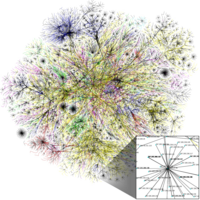
Photo from wikipedia
The ability to recognize the medium access control protocol employed by a network can facilitate the incorporation of a cognitive radio into an existing network by elucidating an integral aspect… Click to show full abstract
The ability to recognize the medium access control protocol employed by a network can facilitate the incorporation of a cognitive radio into an existing network by elucidating an integral aspect of network behavior. Since the way in which users access the electromagnetic spectrum is one of the most prominent distinctions between reservation based and contention based medium access control protocols, the first part of this work exploits the regular timing of transmissions from networks utilizing reservation based time-division multiple access (TDMA) protocols to differentiate between transmissions governed by TDMA and by contention based carrier sense multiple access (CSMA) protocols. Our approach leverages modular arithmetic to identify periodicity in transmission timings and an unsupervised $k$ -means algorithm to generate distinct TDMA and CSMA clusters. Several supervised machine learning algorithms are explored to build a protocol classifier. We then present a method of distinguishing between transmissions from multi-channel frequency division multiple access (FDMA) based networks and single channel networks. This method uses an automated machine learning clustering algorithm to obtain an estimate of the actual center frequencies of channels utilized by a network. Such information can be used to determine whether the network is employing an FDMA protocol to access the electromagnetic spectrum.
Journal Title: IEEE Access
Year Published: 2021
Link to full text (if available)
Share on Social Media: Sign Up to like & get
recommendations!